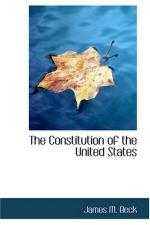Moreover, the patent evidences of weakness in the international organization that we call civilization, the imperative need of ending the spirit of moral anarchy, and the urgent necessity of rebuilding the shattered ruins of the social edifice on surer foundations by the integration of the nations, if possible, into some new form of world organization, gives peculiar interest in these terrible days to the manner in which the American people solved a similar problem more than a century ago.
Then, as now, a world war had ended. Then, as now, half the world was prostrated by the wounds of fratricidal strife. As Washington said: “The whole world was in an uproar,” and he added that the task “was to steer safely between Scylla and Charybdis.” The problem, then as now, was not only to make “the world safe for democracy,” but to make democracy, for which there is no alternative, safe for the world. The thirteen colonies in 1787, while small and relatively unimportant, were, however, a little world in themselves, and, relatively to their numbers and resources, this problem, which they confronted and solved, differed in degree but not in kind from that which now confronts civilization. Impoverished in resources, exhausted by the loss of the flower of their youth, demoralized by the reaction from feverish strife, the forces of disintegration had set in in the United States between 1783 and 1787. Law and order had almost perished and the provisional government had been reduced to impotence. A few wise and noble spirits, true Faithfuls and Great Hearts, led a despondent people out of the Slough of Despond till their feet were again on firm ground and their faces turned towards the Delectable Mountains of peace, justice, and liberty. Let it be emphasized that they did this, not by seeking more power, but by imposing restraints upon themselves. That spirit of self-restraint is the essence of the American Constitution.
So enduring was their achievement that to-day the Constitution of the United States is the oldest comprehensive written form of government now existing in the world. Few, if any, forms of government have better withstood the mad spirit of innovation, or more effectively proved their merit by the “arduous greatness of things done.”
For this reason, as the nations of the world are now trying in a cosmic form and under similar conditions to do that which the founders of the American Republic in 1787 did in a microcosmic form, a short narration of that earlier achievement may not be unprofitable in this day and generation, when we are blindly groping towards some common basis for international co-ordination.
One of England’s greatest Prime Ministers, William Pitt, shortly after the adoption of the Constitution, prophetically said that it would be the admiration of the future ages and the pattern for future constitution building. Time has verified his prediction, for constitution making has been, since the American Constitution was adopted, a continuous industry. The American Constitution has been the classic model for the federated State. Lieber estimated that three hundred and fifty constitutions were made in the first sixty years of the nineteenth century, and, in the constituent States of the American Union, one hundred and three new Constitutions were promulgated in the first century of the United States.




